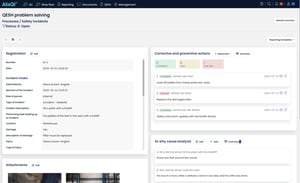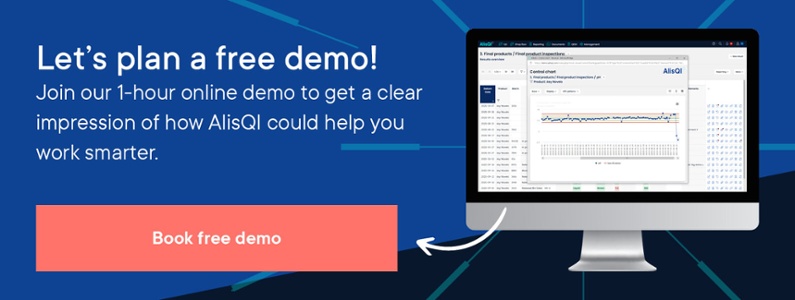Diagnosing and eliminating quality problems is at the heart of all Quality Management. There are several methodologies as to how to do this. One of the most widely implemented is 8D problem solving. This tried-and-true methodology gives teams a comprehensive and consistent way to address production problems, no matter where they are triggered along the production chain.
Several articles elaborate on why it’s important to diagnose and eliminate quality problems using the 8Ds. But how does this work if you’re using quality management software? Let’s find out
A quick intro to 8D problem solving
The Eight Disciplines of problem solving (8D) provides manufacturers with a team-oriented approach to addressing problems in the production cycle. It’s widely used throughout manufacturing and combines best practices from a variety of approaches to create a “best of all worlds” scenario. High-level goals folded into the 8D process include:
- Identifying the root cause of a problem
- Developing containment actions that protect customers
- Identifying the root cause of a problem
Organizations that employ 8D should experience systemic changes to their production process. They will also be able to improve and streamline the whole process. This helps them to eliminate the problem at hand but also reduce the occurrences of other problems down the line
So, what do the 8Ds stand for?
To achieve the high-level goals described above, a team should pursue these eight steps:
- Define the stakeholders addressing the problem.
- Develop a Problem Statement that correctly summarizes and defines the problem.
- Define and execute an interim containment action.
- Document the root cause of the non-conformance or non-detection, along with the percentage at which it contributed to the problem.
- Define, select, and verify Corrective Action(s) needed to address the problem.
- Implement and validate the Corrective Action(s).
- Document all actions taken to prevent recurrence.
- Document and acknowledge the team contributions that led to the success of this process.
When to apply 8D problem solving
Typically, 8D is most applicable in the following scenarios:
- when safety or regulatory issues have come up in the production cycle
- if your company receives multiple and consistent customer complaints
- when warranty responses suggest product failure rates that are higher than expected
- in case internal factors such as waste, test failures, rejects or poor performance occur at unacceptably high levels
Why apply 8D problem solving
Next to a collaborative and consistent way to address production problems, 8D also delivers other benefits including but not limited to:
- developing team-wide skills when it comes to solving production problems
- creating an ongoing record of failures that can inform problem solving efforts to come
- improved understanding of statistical tools leveraged in problem solving
- improved efficiency and effectiveness in team efforts to solve problems
- a better understanding of RCA (Root Cause Analysis)
- developing problem solving skills that can be adapted for other areas/departments in a company
- enhanced skills when it comes to taking corrective actions
- enhanced collaboration and discussions around problem solving
- enhanced ability by the team to identify where change is needed
- improved management understanding of processes
How to leverage 8D if using quality management software
One of the most effective ways to leverage the 8D method is by applying it using a smart QMS. The cloud-based quality management system from AlisQI was designed to help manufacturers work smarter, not harder. We automate data collection, data analysis, project management and other routine tasks so that manufacturers can focus on continuous improvement.
Within AlisQI manufacturers have a QESH problem-solving page, a standardized dashboard based on the 8D methodology. Whether it’s a complaint, deviation or safety incident, this page provides all the components you need to analyze, follow up on and report production problems. It is available for all QESH processes, no matter their context.
A closer look at the Problem-solving page
The QESH problem-solving page is divided into four sections. Together, they make for an integrated approach to problem solving. To be more specific:
- Incident details This presents all information entered via the form to register or follow up on an incident. The form can be fully tailored. It details tasks leading up to the incident, the damage that occurred as well as immediate actions that have been taken.
- Attachments Uploaded images depicting the incident are shown right away. Other file types are linked and easily accessible. Teams can add just about any file type as an attachment. Typical examples include images, Word, Excel, PPT, or PDF files.
- CAPA actions Shows all connected corrective or preventive actions related to the incident, with their owner, due date, and status. The moment you assign an action, the action owner is informed automatically. The CAPA actions are managed centrally, so you always know who is doing what.
- Root cause analysis The lower right quadrant shows an example of five times why root cause analysis. This allows for a systematic approach to root cause findings.
Additionally, the smart QMS allows for the creation of full-featured 8D reports (including all actions and their status).
Do you want to learn more and actively use 8D problem solving to improve production? Book a free online demo, and we’ll show you how to set up effective QESH management so that you can focus on improving your business.



